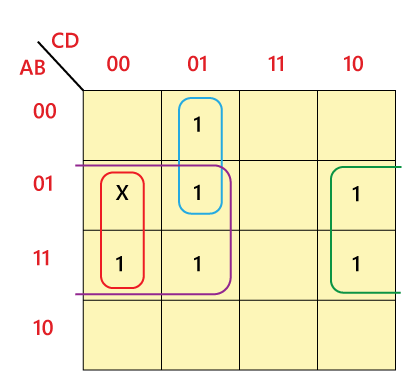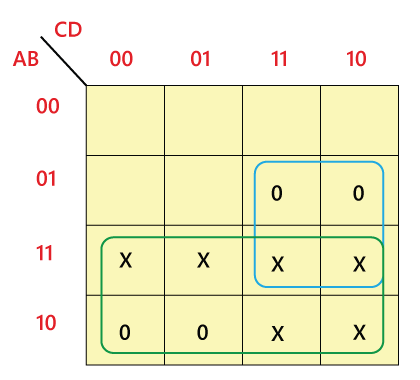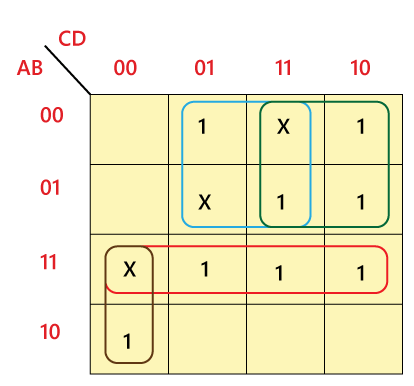Don't Care ConditionThe "Don't care" condition says that we can use the blank cells of a K-map to make a group of the variables. To make a group of cells, we can use the "don't care" cells as either 0 or 1, and if required, we can also ignore that cell. We mainly use the "don't care" cell to make a large group of cells. The cross(×) symbol is used to represent the "don't care" cell in K-map. This cross symbol represents an invalid combination. The "don't care" in excess-3 code are 0000, 0001, 0010, 1101, 1110, and 1111 because they are invalid combinations. Apart from this, the 4-bit BCD to Excess-3 code, the "don't care" are 1010, 1011, 1100, 1101, 1110, and 1111. Example 1: Minimize f = m(1,5,6,12,13,14) + d(4) in SOP minimal form Solution: The k-map of the given function in the SOP form is as follows: 
So, the minimized SOP form of the function is: f = BC' + BD' + A'C'D Example 2: Minimize F(A,B,C,D) = m(0,1,2,3,4,5) + d(10,11,12,13,14,15) in SOP minimal form Solution: The POS form of the given function is: F(A,B,C,D) = M(6,7,8,9) + d(10,11,12,13,14,15) The POS K-map for the given expression is: 
So, the minimized POS form of the function is: F = A'(B' + C') Example-3: Explanation: The SOP K-map for the given expression is: 
Therefore, f = AC'D' + A'D + A'C + AB Significance of "Don't Care" Conditions:Don't Care conditions has the following significance with respect to the digital circuit design: Simplification: These conditions denote the set of inputs that never occurs for given digital circuits. Therefore, to simplify the boolean output expressions, the 'don't care' are used. Reduced Power Consumption: The switching of the state is reduced when we group the terms long with "don't care". This reduces the required memory space resulting in lower power consumption. Lesser number of gates: For reducing the number of gates that are used to implement the given expression, simplification places an important role. So, the 'don't care' makes the logic design more economical. Prevention of Hazards: In the digital system, the 'don't care' place an important role in hazards prevention. States in Code Converters: These also play an important role in code conversion. For example- In the design of a 4-bit BCD-to-XS-3 code converter, the input combinations 1010, 1011, 1100, 1101, 1110, and 1111 are don't cares.
Next TopicBinary to BCD code conversion
|
 For Videos Join Our Youtube Channel: Join Now
For Videos Join Our Youtube Channel: Join Now
Feedback
- Send your Feedback to [email protected]
Help Others, Please Share










